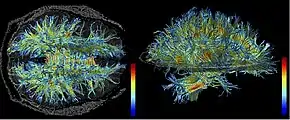General movements assessment
A general movements assessment is a type of medical assessment used in the diagnosis of cerebral palsy,[1] and is particularly used to follow up high-risk neonatal cases.[2] The general movements assessment involves measuring movements that occur spontaneously among those less than four months of age and appears to be most accurate test for the condition.[1][3]

These include the tonic neck reflex, grasp reflex, Moro reflex, tongue thrust reflex and rooting reflexes.[4] The quality of the child's general movements gives information about how the brain connects, particularly the periventricular white matter.[5]
The GMA is best performed 3 months post-term (if the child was born prematurely, the assessment date is not at three months old, but is conducted at the same time as if they were born at term).[5] At around that time, in typical infants, a pattern called 'fidgety movements' is evident, and if the movements are abnormal or the fidgety movements are not apparent, the child is at risk of developing CP.[6] A pattern known as 'writhing movements' frequently gives false positives for cerebral palsy.[7]
See also
References
- McIntyre, S; Morgan, C; Walker, K; Novak, I (Nov 2011). "Cerebral palsy--don't delay". Developmental Disabilities Research Reviews. 17 (2): 114–29. doi:10.1002/ddrr.1106. PMID 23362031.
- Graham, David; Paget, Simon P; Wimalasundera, Neil (February 2019). "Current thinking in the health care management of children with cerebral palsy". Medical Journal of Australia. 210 (3): 129–135. doi:10.5694/mja2.12106. PMID 30739332. S2CID 73424991.
- Bosanquet, M; Copeland, L; Ware, R; Boyd, R (May 2013). "A systematic review of tests to predict cerebral palsy in young children". Developmental Medicine and Child Neurology. 55 (5): 418–26. doi:10.1111/dmcn.12140. PMID 23574478.
- Robin C. Meyers; Steven J. Bachrach; Virginia A. Stallings (2017). "Cerebral Palsy". In Shirley W. Ekvall; Valli K. Ekvall (eds.). Pediatric and Adult Nutrition in Chronic Diseases, Developmental Disabilities, and Hereditary Metabolic Disorders: Prevention, Assessment, and Treatment. Oxford Scholarship Online. doi:10.1093/acprof:oso/9780199398911.003.0009. ISBN 9780199398911. Retrieved 1 August 2017.
- Hadders-Algra, Mijna (24 September 2014). "Early Diagnosis and Early Intervention in Cerebral Palsy". Frontiers in Neurology. 5: 185. doi:10.3389/fneur.2014.00185. PMC 4173665. PMID 25309506.
- Herskind, Anna; Greisen, Gorm; Nielsen, Jens Bo (January 2015). "Early identification and intervention in cerebral palsy". Developmental Medicine & Child Neurology. 57 (1): 29–36. doi:10.1111/dmcn.12531. PMID 25041565.
- Kwong, Amanda K L; Fitzgerald, Tara L; Doyle, Lex W; Cheong, Jeanie L Y; Spittle, Alicia J (22 February 2018). "Predictive validity of spontaneous early infant movement for later cerebral palsy: a systematic review". Developmental Medicine & Child Neurology. 60 (5): 480–489. doi:10.1111/dmcn.13697. PMID 29468662.